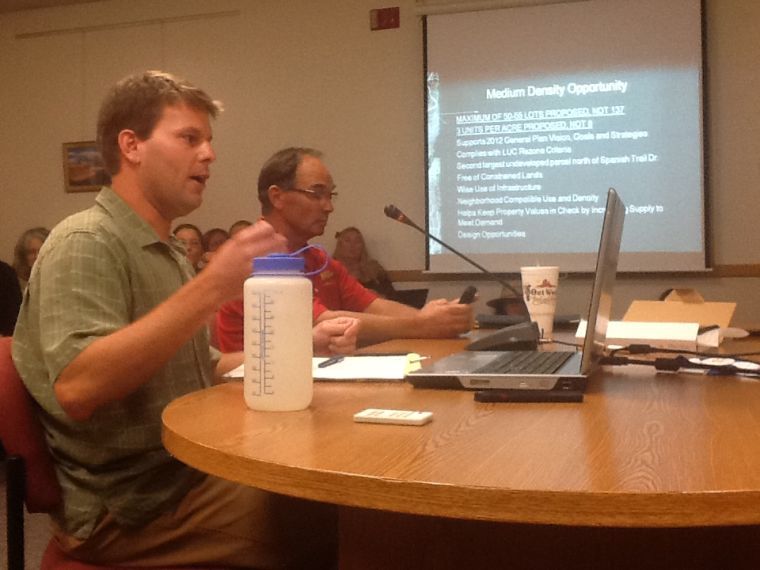Some information may be outdated.
Residents protesting the rezone for a 17-acre parcel near Old City Park in Spanish Valley filled the Grand County Council chambers and spilled into a crowded hallway during the council’s meeting Tuesday, Sept. 17.
In August, Randy Day, a developer with Red Rock Partners, asked the Grand County Planning Commission to consider a land use code change from Rural Residential (RR) to Small Lot Residential (SLR). Despite the commission’s recommendation to not rezone, Day presented the request before the Grand County Council.
The council held a public hearing to learn more about the rezone request, as well as hear the opinions from residents who live in the area. More than 100 citizens attended the meeting.
Council chair Gene Ciarus set the rules at the beginning of the public hearing.
“Those who have cell phones, please turn off or silence. I want everybody here to observe the utmost decorum. I will conduct a very strict meeting,” Ciarus said. “Those who create a disturbance will be asked to leave. If it gets out of hand, we have law enforcement to escort them out of the building.”
The council will continue to consider written comment regarding the zone change until Thursday, Sept. 27, and may make a decision regarding the rezone at their Tuesday, Oct. 1 meeting.
Randy Day said Monday, Sept. 23 that he is considering pulling the rezone request from the Oct. 1 agenda.
“This is so contentious,” Day said. “I don’t know what to do. I’m upset. I’m discouraged.”
Many of the citizens protesting the zone change expressed strong concern that a change to SLR would create high-density housing in a rural setting.
RR zone is set for one home per acre, but allows for a maximum of 1.6 units per acre if land conservation and other developer incentives are met. SLR zone is for five homes per acre, but if land conservation incentives are met, up to 8 units per acres may be allowed. With 17 acres, that could allow up to a maximum of 136 units.
Day said that the project is being misrepresented. He said doesn’t want to build 136 units. He wants to build 54.
“I want to do a single-family residential area much like the Solano Vallejo subdivision, with lots that average a little under 10,000 square feet,” Day said. “That’s just a little under a quarter-acre. The code won’t allow me to build that.”
Land planner Dan Burkhart, from Durango, Colo., made a presentation on behalf of Red Rock Partners to the council to show flaws he saw in the Future Land Use Plan and the county’s zoning.
Many of the residents in attendance were from the Highland subdivision that is adjacent to the 17-acre parcel. While the majority of the Highland subdivision lots are at least one-acre, it is zoned as SLR.
“It was rezoned after it was developed for non-conforming lot sizes,” said Krissie Braun, the county’s community development director, during her presentation during the public hearing. “Highland subdivision was subdivided in the 1960s as the current subdivision sits now. It had less than one-acre lots in it. When the land code was last amended, it was rezoned to meet the current uses on the ground.
“I’m asking for the very same zone that those people live in,” Day said. “I’m asking for the same zone that Solano Vallejo is in.”
Grand County’s General Plan, which was updated in 2012, specifies land designation by density: from residential infill; to transition residential for half-acre lots; to rural residential for one-acre lots; and, finally range, resource and recreation for a minimum of 5-acre lots. These designations are set to have compact housing closer to Moab and a pattern of increasingly rural character moving away from the city.
Many of the letters sent to the council before the meeting stated a concern that if the parcel was rezoned to SLR, that Day could put in high-density housing, or sell it to another developer who would put in high-density housing.
Don Knowles’ property on Cedar Hills is adjacent to the parcel.
“We never figured we’d have 137 units in front of us,” Knowles said. “Randy had said tonight that isn’t going to happen. If that doesn’t happen, that’s much better.”
Greg Kennedy, a Highland subdivision resident, said that the parcel doesn’t meet the criteria of the general plan for spot zoning.
“They knew what it was zoned before they bought it,” Kennedy said. “No one has a problem with them building 17 homes, or selling 17 lots.”
Saxon Sharpe, whose home backs up to Spanish Trail Road, expressed concern that the necessary infrastructure isn’t in place for safe travel should additional homes be built.
“Every morning people are running, riding bicycles, walking dogs on Spanish Trail Road. There are no sidewalks,” Sharpe said. “If there is a minimum of 54 houses, that’s another 100 cars. Infrastructure should be there before you increase density.”
Thea Nordling acknowledged that the community is growing, but emphasized a need to follow the Future Lane Use Plan (FLUP) and general plan.
“I know our community is growing and changing, and will continue to do so in a positive way. FLUP and the county’s general plan provide for sustainable growth,” Nordling said. “We shouldn’t throw our land use plan away. One developer’s desire for maximum profit shouldn’t be considered to throw away our land plan.”
Day said that he was willing to put a deed restriction on the property to limit it to fewer homes should the parcel be granted a rezone.
“I put my guarantee out there of what I will do,” Day said.
As of Monday, Sept. 23 Day hadn’t made a final decision whether to remove the rezone request from the council’s Oct. 1 agenda.
“I haven’t decided yet,” Day said. “I’m going to read the code and look at my options.”
Appreciate the coverage? Help keep local news alive.
Chip in to support the Moab Sun News.





